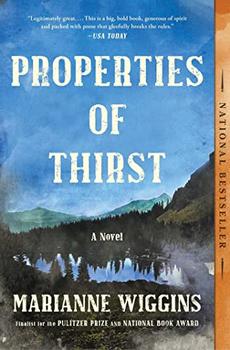Summary | Excerpt | Reviews | Beyond the Book | Read-Alikes | Genres & Themes | Author Bio

Critics' Opinion:
Readers' Opinion:
First Published:
Aug 2022, 544 pages
Paperback:
May 2023, 544 pages
 Book Reviewed by:
Book Reviewed by:
Kim Kovacs
Buy This Book
This article relates to Properties of Thirst
 In Marianne Wiggins' novel, Properties of Thirst, one of the main characters is in an ongoing battle with the Los Angeles Department of Water over their aqueduct installation in California's Owens Valley.
In Marianne Wiggins' novel, Properties of Thirst, one of the main characters is in an ongoing battle with the Los Angeles Department of Water over their aqueduct installation in California's Owens Valley.
Los Angeles was officially founded on September 4, 1781 as part of Spain's colonization of California. As the town grew so did its water needs, and over time a series of canals and reservoirs were built to take advantage of the Los Angeles River and its tributaries. By the end of the 19th century, however, it was becoming clear that the existing water supply would be insufficient to support the burgeoning population.
The water system had been managed by a private corporation, the Los Angeles City Water Company, with William Mulholland as its superintendent. Mulholland was a self-trained engineer, born in Ireland, who'd started out as a ditch digger for the company. In 1902, the city bought out the business and formed the Los Angeles Department of Water and Power, retaining Mulholland at the helm.
Mulholland began searching for other water sources, eventually settling on the Owens River, some 200 miles away on the far side of the Sierra Nevada, a rugged mountain range to the east of LA. The farmers and ranchers of Owens Valley had their own plans for an irrigation system and were in the process of seeking federal funding for it. Mulholland, however, teamed with the well-connected Fred Eaton — former mayor of LA — to block the project (likely through bribery and deception). One of the most diabolical aspects of their plan was that they bought the water rights to the Owens River from the government, planning to divert all the water from it, effectively leaving the residents with worthless land — without water it couldn't sustain crops or support livestock. Their scheme was further supported by a syndicate of wealthy businessmen, primarily railroad magnates, who'd bought up much of the land through which the proposed aqueduct would run (because LA Water would need to pay to run the pipeline across the land it was a very lucrative investment). A $1.5 million bond measure was passed in 1905, allowing planning to begin, followed by a second, $23 million bond measure two years later.
Construction started in 1907, and 4,000 laborers were hired. Workers excavated 142 tunnels that added up to 43 miles in length, the largest of which, the Elizabeth tunnel, ran over five miles. The crews worked at such a pace that they set a world record for hard rock tunneling, completing 604 feet in a single month. The digging of this tunnel, expected to take five years, was completed 20 months early.
Most of the material used in construction was concrete. Mulholland had a cement plant built nearby at a large limestone deposit, and the resulting camp, which he dubbed Monolith, housed the plant's workers. In addition, two hydroelectric plants were built to supply energy to the project. New technologies were also employed, such as the use of a traction engine to replace mules for hauling heavy loads. Unfortunately, the tractors were no match for the Mojave Desert. Breakdowns became so frequent that those in charge of the project reverted to using mule teams.
When completed in 1913, the aqueduct ran 233 miles through canals, tunnels and pipes before emerging into a spillway in the San Fernando Valley (it was extended another 100 miles north in the 1940s). At the time, it was the longest aqueduct in the world, as well as the largest single water project ever undertaken.
Although it was an engineering marvel as well as a real boon for the financiers and the people of LA, the aqueduct had devastating consequences for the residents of Owens Valley. Not only did it force the area's farmers and ranchers to abandon their homesteads because of a lack of water, but it gradually transformed the 108-square mile Owens Lake into a toxic dust bowl as the water that fed it was diverted. The dust presented a significant health hazard and had a negative impact on wildlife. After decades of litigation (known as the "California Water Wars"), the Los Angeles Department of Water and Power, the City of Los Angeles and the State of California agreed to begin mitigation efforts. The dust at Owens Lake has been significantly reduced and efforts to reestablish habitats continue today.
Opening of the LA Aqueduct's gates, 1913, courtesy of Water and Power Associates
Filed under Places, Cultures & Identities
![]() This "beyond the book article" relates to Properties of Thirst. It originally ran in October 2022 and has been updated for the
May 2023 paperback edition.
Go to magazine.
This "beyond the book article" relates to Properties of Thirst. It originally ran in October 2022 and has been updated for the
May 2023 paperback edition.
Go to magazine.




Heaven has no rage like love to hatred turned, Nor hell a fury like a woman scorned.
Click Here to find out who said this, as well as discovering other famous literary quotes!
Your guide toexceptional books
BookBrowse seeks out and recommends the best in contemporary fiction and nonfiction—books that not only engage and entertain but also deepen our understanding of ourselves and the world around us.